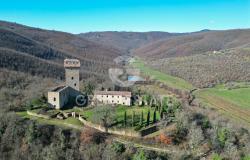Hanging by a thread off laden branches, chestnuts sparkle like dark jewels. They look like huge, fat raindrops, and gleam with a perfect deep brown gloss against the golden spines of the half-open burrs that hold them. Deep inside—wrapped securely in the shiny peel's firm cocoon, sheltered by what remains of the prickly burrs—the straw-yellow core is ripening, getting ready to yield its sweet, nutty flavour to the voracious embrace of a roasting pan.
Soon starch will turn into sugar and the chestnuts will start falling with muffled thuds on the mossy undergrowth that carpets woods from Piedmont to Tuscany. Soon the nuts' warm, uncomplicated sweetness will feed Italians up and down the country—as it has done every autumn for the last few millennia.

Europe's oldest living chestnut tree, which stands in Sicily, is reputed to be more than 3,000 years old. It is so big that legend wants it to have given shelter to a medieval queen, Joan of Aragon, and her escort of 100 knights on a stormy evening. If the story is true, it was already there when the Romans, who were great fans of the plant, started planting chestnut trees along the length and breadth of the Mediterranean basin. The sweet nuts were so popular that even the empire's greatest poets sung of them in their work—in the Eclogues, Virgil recalled a dainty dish of chestnuts cooked in milk and eaten with cheese, while Martial raved about the roast ones he had in Naples.
In some areas, such as the Tuscan Apennine, chestnuts were the main staple since Roman times and throughout the Middle Ages - chiefly because of their nourishing qualities, though their reputation as aphrodisiacs can't have hurt.
Although it mostly fodder for the poor, the humble nut also attracted the attention of the rich and powerful, who saw it as an easy way to feed the masses. Countess Matilde of Canossa - better known for having engendered a fleeting reconciliation between German king Henry IV and Pope Gregory VII in 1077 and later inflicted a crushing defeat on the excommunicated Henry—was indefatigable in having chestnut trees planted across her vast estates. She was so keen on them that she even came up with a planting scheme detailing the optimal distance between one tree and the next (later named the stadio matildico after her).

And although the riches of the 20th century—together with the population decline across Italian mountains and a rise in the incidence of blights and diseases - caused a drop in chestnut consumption throughout Italy, their gastronomic tradition remained alive, as did the many recipes that had evolved over time. Which is why, now that the nuts enjoy renewed popularity, partly thanks to the boom in healthy eating, they find many creative uses in Italian kitchens beyond the delicious but slightly obvious roasting and boiling.
From the Mugello, a chestnut-peppered mountainside between Florence and Bologna, comes the polenta di castagne. This simple but filling dish, made with chestnut flour cooked in water, and served with cheese, sausages or meat sauce, dates back to well before the days when corn became popular and polenta as we know it today was born.
Also from Tuscany comes castagnaccio, a thin, textured, nutty cake made with chestnut flour peppered with pine nuts and rosemary. Even richer is Monte Bianco, a rum-drizzled mountain of chestnut puree and cocoa, covered by a snow-white blanket of whipped cream, which happens to be one of writer Susanna Tamaro's favourite dishes. And of course there are chestnut-filled tortelli, chestnut flour fritters. and the velvety marmellata di marroni—a chestnut puree blended with syrup and cooked until it becomes a deliciously sweet cream.
But chestnuts have recently made their way into the repertoire of many great Italian chefs and pasticceri, who are making the most of the nuts' sweet, slightly smokey flavour to create new classics. Among the most mouthwatering creations are a soft chestnut mousse served with hot chocolate sauce (at Trattoria dall'Amelia in Mestre), pear and chocolate tart with a chestnut flour base (at Aimo & Nadia in Milan) or chestnut profiteroles with bay leaf cream and persimmon sauce (at Scala in Castelnuovo di Garfagnana) or chocolate and chestnut croquant (at L'Osteria Francescana in Modena). But you'll also comes across golden chestnut ravioli sprinkled with cheeses, savoury chestnut flour tagliatelle with seafood, velvety chestnut soup, and boiled chestnut or chestnut puree as an accompaniment to meat and game roasts.
The best places to savour the nuts, both in traditional and innovative recipes, are the areas of production.Virtually every hill or mountain wood in Italy will have a chestnut grove - they cover some 15% of Italy's wooded surface—but the most acclaimed nuts come from Tuscany, Piedmont and Campania.
Marroni del Mugello
In Tuscany, the best ones come from the Mugello - specifically from the village of Marradi - and from the Monte Amiata. The Marroni del Mugello are deep brown chestnuts with a markedly sweet flavour and notes of vanilla. Boiled, pureed and mixed with parmesan, they make a delicious filling for the Mugello's delicate tortelli, a ravioli-like pasta that is served simply with butter and parmesan. But the most popular use is to make Torta di marroni, a rich shortcrust pastry tart filled with a chestnut puree batter flavoured with rum.
Monte Amiata chestnuts and Castagne Cuneo
The Monte Amiata chestnuts, by contrast, are cream hued in a red-tinged peel, and have a delicately sweet taste. Their production is strictly regulated to ensure quality. Monte Amiata chestnut can be roasted, used to make castagnaccio, cooked in vanilla- or cinnamon-scented milk, or boiled and added to chickpea soup. Also delicate and sweet are the Castagne Cuneo, which come from the countryside around the provincial capital of Cuneo, in Piedmont, where they have been produced for more than 900 years. They are eaten boiled or roasted, alone or as a side dish to pork and deer roasts. And of course they find their way innto rich desserts, such as the mundaj, a chestnut-studded chocolate roulade.
Montella's chestnuts
On the opposite side of Italy, in Campania, the best chestnut come from the village of Montella. They are small and round, with a white, crunchy, perfectly sweet core inside a rich brown peel. They can be roasted of course, but they give their best in cakes and desserts - a traditional one is the Castagne del Prete, where chestnuts are dried, toasted, then soaked in water to acquire an intensely brown hue and a caramelised flavour.
The best time to visit any of these chestnut producing countries is of course early autumn. It's then that the freshest chestnuts hit the market stalls, a fact that is often celebrated with loud, buzzy street festivals. Just remember not to buy too many. Unlike other nuts, chestnuts have a relatively short shelf life - washed, accurately dried and stored in a cool, dry place they will last for a couple of months. Dried chestnuts will last longer, while chestnut flour, which also needs to be stored in a cool dry place, will go stale very quickly once the pack has been opened.
Chestnut Festivals Date and Videos
The following Videos include tips on how to roast chestnuts at home and some of the Chestnut Festivals in Italy - dates listed below.
Upcoming chestnut festivals - street music, performances, and plenty of excellent chestnuts to munch on:
-
Sagra delle castagne, Marradi, on 7, 14, 21 and 22 October 2009
-
Chestnut festivals of Garesio, Piasco, Frabosa Soprana, Pamparato, Roburent, and Roccabruna (all villages in the Cuneo province) on 11 October
-
La castagna in festa, Arcidosso, between 16 and 25 October
-
Chestnut festivals of Frabosa Sottana, Montaldo Mondovi, Roburent, Roccavione and Benasco (villages in the Cuneo province) on 18 October
-
Sagra della castagna, Montella, on 7 and 8 November 2009
If you know about some delicious Chestnuts recipes, don't hesitate to add them in our Community Food and Wine pages.













